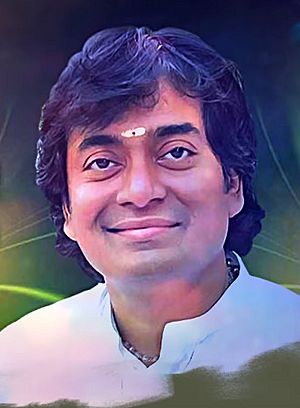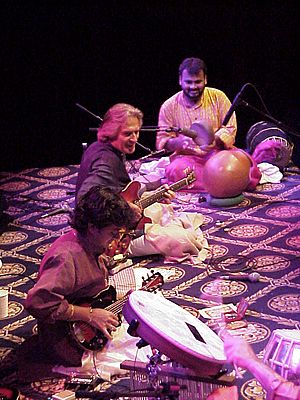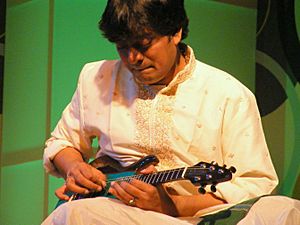U. Srinivas facts for kids
Quick facts for kids
U. Srinivas
|
|
|---|---|

U. Srinivas
|
|
| Background information | |
| Native name |
ఉప్పలపు శ్రీనివాస్
|
| Birth name | Uppalapu Srinivas |
| Also known as | U. Srinivas, Mandolin Srinivas |
| Born | 28 February 1969 Palakollu, West Godavari District, Andhra Pradesh, India |
| Origin | Andhra Pradesh, India |
| Died | 19 September 2014 (aged 45) Chennai, Tamil Nadu, India |
| Genres | Indian classical music |
| Occupation(s) | Musician (Mandolin Maestro) |
| Instruments | Electric Mandolin |
| Years active | 1978–2014 |
| Labels | Real World Records Virgin Classics/EMI |
| Associated acts | Remember Shakti |
Uppalapu Srinivas (born February 28, 1969 – died September 19, 2014) was an Indian musician. He played the mandolin in a style called Carnatic classical music, which is a traditional music form from South India. He was known as a child prodigy, meaning he was incredibly talented at a very young age. Because of his amazing talent, some people called him the "Mozart of classical Indian music."
The Government of India gave him the Padma Shri award in 1998. This is one of the highest awards a civilian can receive in India. He also received the Sangeet Natak Akademi Award in 2009. This award comes from India's National Academy of Music, Dance & Drama.
Contents
Early Life and Musical Beginnings
Srinivas was born on February 28, 1969, in a place called Palakollu in Andhra Pradesh, India. When he was just five years old, he heard his father, U. Satyanarayana, playing the mandolin at a concert. Srinivas was so interested that he picked up his father's mandolin and started playing it himself.
His father, who also studied classical music, quickly saw how talented his son was. He bought Srinivas a new mandolin and began teaching him. Later, a family friend, Vasu Rao, introduced seven-year-old Srinivas to Western music in 1976.
Soon, his father's music teacher, Rudraraju Subbaraju, started teaching Srinivas too. Even though Rudraraju Subbaraju didn't play the mandolin, he would sing classical Indian music pieces. Young Srinivas, only six years old, would play these songs on his mandolin. This helped him create his own amazing way of playing. It was surprising because the mandolin had never been used to play the difficult Carnatic style before.
Later, his family moved to Chennai. This city is a major center for Carnatic music, where many famous musicians live. When Srinivas gave his first concert, people were amazed. They compared him to other famous child geniuses like Wolfgang Amadeus Mozart. From a young age, many people saw him as a future leader in Indian music, like the famous Pandit Ravi Shankar.
A Career in Music
Srinivas gave his first public Carnatic music concert in 1978. This was at the Thyagaraja Aradhana festival in Gudivada, Andhra Pradesh. Then, when he was eleven years old in 1981, he performed in Chennai. This concert was at the Indian Fine Arts Society during the December Music Season. After that, his career took off!
He first played the acoustic mandolin, which is a mandolin that doesn't need electricity. But he later switched to the electric mandolin. He felt the electric mandolin helped him play long, smooth notes better. These long notes are very important in classical Indian music. The electric mandolin also made his music clearer to hear.
Srinivas was the first musician to use the electric mandolin in Carnatic music. He changed the Western electric mandolin to fit the Indian style. He used five single strings instead of the usual four doubled strings. This helped him play the special pitches and raga (musical scales) of Carnatic music. It also helped him create gamakas, which are special musical decorations or vibrations.
Starting in 1982, he performed regularly at the famous Madras Music Academy in December. He played there every year, except in 2002. December 23rd was always his reserved day to perform, which was a great honor.
When Srinivas was thirteen, he played at the Berlin Jazz Festival. He was supposed to play for only half an hour after the famous musician Miles Davis. But Srinivas received a standing ovation, and he ended up playing for another hour! The legendary trumpeter Don Cherry said, "He's got it in him. He's fantastic."
The guitarist John McLaughlin heard a recording of this concert and was very impressed. Srinivas also performed at the Olympic Arts Festival in Barcelona in 1992. In 1995, he recorded a successful album with Michael Brook that blended different music styles.
In 1997, John McLaughlin started his group Shakti again, renaming it Remember Shakti. He asked Srinivas to join the group and tour the world. Srinivas became a main player in the group, along with other Indian musicians like Zakir Hussain and Shankar Mahadevan. Srinivas traveled widely on his own too, performing in Australia, Asia, and many cities across the United States and Canada.
His talented younger brother, U. Rajesh, studied with Srinivas for about 27 years. Rajesh is also a skilled mandolin player. He often played with Srinivas at concerts during the last 20 years of Srinivas's life. Rajesh also plays jazz and Western music. He played mandolin on John McLaughlin's album Floating Point, which was nominated for a Grammy Award in 2008.
Srinivas and Rajesh also wrote music together. Besides Carnatic music, they worked a lot on mixing Carnatic and Western music. They performed with the Johannesburg Philharmonic Orchestra and other famous musicians. Srinivas once compared Carnatic music to the Sanskrit language. He said, "It's the basis, from which spring so many other languages. Carnatic music is here to stay with us and all other music that we play is based on that."
Over his career, Srinivas recorded more than 137 albums. These included Carnatic music solos, jugalbandi (duets) with Hindustani musicians, and world music. He played with Western artists like John McLaughlin and Michael Brook. He also performed with Hindustani music artists like Hariprasad Chaurasia and Zakir Hussain.
U. Srinivas started a music school in Chennai called the Srinivas Institute of World Music (SIOWM). He taught many students there for free, starting when he was only eighteen. Srinivas trained almost a hundred students around the world. Many of them studied with him and U. Rajesh for up to ten years. His brother, U. Rajesh, continues to teach their students at the SIOWM.
His Special Mandolin
Srinivas's first mandolin belonged to his father, who played the clarinet. That mandolin was a standard Western mandolin. However, Srinivas changed it over time to fit his unique playing style.
He started with an acoustic mandolin. But its size and the way it needed to be plucked weren't good for playing long, smooth notes. So, he switched to the electric mandolin. This instrument was much better for holding notes and adding musical decorations.
A typical mandolin has eight strings, tuned in pairs. But Srinivas usually used only five single strings, tuned to CGCGC. You can find copies of this type of mandolin in India. Several other Indian mandolin players, including his brother U. Rajesh, use similar instruments. The design of his mandolin and its special string setup are patented in India and the USA.
Personal Life
Srinivas married U. Sree in 1994. She was a veena player. They had a son named Sai Krishna.
U. Srinivas was a very devoted follower of the Paramacharya of Kanchi. He also followed Sri Sathya Sai Baba and performed for him many times.
Illness and Passing
Srinivas, also known as Mandolin Shrinivas, was getting treatment for a liver problem. He had a liver transplant on September 11, 2014. Sadly, he passed away on September 19, 2014, at Apollo Hospital after having complications.
Awards and Achievements
Here are some of the awards Mandolin U. Srinivas received:
- Padma Shri in 1998, from the Government of India
- Sangeet Natak Akademi Award in 2010, from the Sangeet Natak Akademi
- Sangeet Ratna
- Sanatan Sangeet Puraskar from Sangeet Sanskriti
- Titled ′Asthana Vidwan′ (Royal Musician) at age 15 in July 1984, and by several temples and spiritual centers
- Raja-Lakshmi Award in 1985 from Sri Raja-Lakshmi Foundation, Chennai
- T. Chowdiah Memorial National Award, Mysore, Karnataka in 1992
- Sangeetha Bala Bhaskara by Sangeetha Kalanidhi M.S. Subbulakshmi in 1995
- Sangeetha Choodamani Award in 1985
- National Citizen's Award, 1991 by the President of India
- Special TTK Award and Best Artist Award by the Madras Music Academy in 1983 and 1993
- Rajiv Gandhi National Integration Award
- Madhya Pradesh Government Award, in 2004
- Maharajapuram Santhanam Award, in 2010
- Lifetime Achievement Award, in 2014 by Mahindra Finance
Discography
U. Srinivas recorded a CD of Carnatic songs by Ilaiyaraaja called Ilaiyaraaja's Classics in Mandolin. In 2008, he released Samjanitha, which featured many other musicians like Debashish Bhattacharya, John McLaughlin, and Zakir Hussain.
Here is a partial list of his albums:
- Mandolin - Master U. Srinivas (Magnasound, 1986)
- Mandolin Ecstasy (Oriental, 1986)
- Magic Mandolin (Chhanda Dhara, 1989)
- Music on Mandolin (Super Cassette, 1990)
- Double Mandolin (The Master Company, 1991)
- Modern Mandolin Maestro (GlobeStyle, 1991)
- Trio Mandolin (Koel, 1992)
- Mandolin Duets (EMI, 1994)
- Prodigy (Koel, 1994)
- Rama Sreerama (Real World Records, 1994)
- Dream, with Michael Brook (Real World/Virgin/EMI, 1995)
- Dawn Raga (Womad, 1996)
- Marvels on Mandolin (Magnasound, 1996)
- Mandolin (Geethanjali, 1998)
- Mystic Raptures (Music Today, 2000)
- Remember Shakti: The Believer (Verve/Universal, 2000)
- Mandolin Magic (Dunya, 2001)
- Gamanashrama (Charsur, 2003)
- Sangam: Michael Nyman Meets Indian Masters (WEA, 2003)
- Om Nama Shivaya (Sea, 2004)
- Five Star (Saregama 2004)
- Mandolin Melodies: South Indian Classical Music (Felmay, 2005)
- Ragasangamam (Music Today, 2006)
- Sahavaadhan (Living 2006)
- Samjanitha (Dreyfus Records, 2008)
- Chinnanchiru Kiliye (Music Today, 2011)
- Sangeet Santaj Vol. 1 & 2 (Music Today, 2011)
- Ru-Ba-Ru: A Unique Confluence of Sarangi & Mandolin (Music Today, 2011)
- Dikshitar Masterpieces (Music Today, 2011)
For the Sangeetha Music label, U. Srinivas recorded these albums:
- Mokshamugalada
- Nadasudharasa
- Double Mandolin
- Meenakshi Memudam
- Pancharatna Kritis –Trio Mandolin
- Magnetic Mandolin
- Naada Brahmaanandam (Double Mandolin)
- Naanu Palimpa
- Vaathapi on Mandolin
- Endaro Mahanubhavulu
- Enduko Dayaradura
- Gaana Sampoornam
- Mandolin Ganamrutham
See also
 In Spanish: U. Srinivas para niños
In Spanish: U. Srinivas para niños



